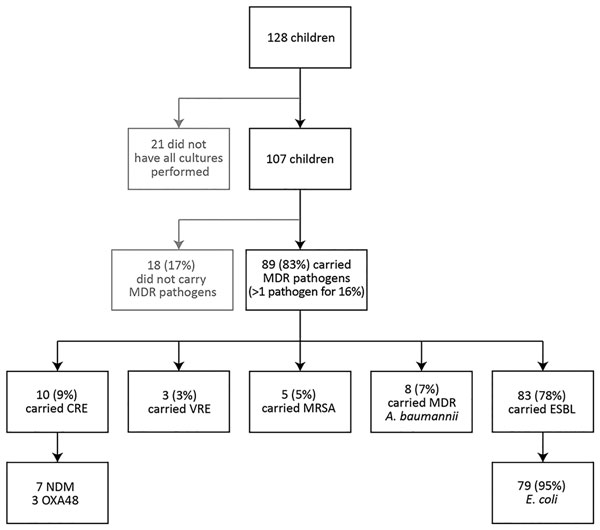Volume 23, Number 1—January 2017
Letter
Multidrug-Resistant Pathogens in Hospitalized Syrian Children
Figure

Figure. Carriage of MDR pathogens from 5 pathogen groups in 107 Syrian children treated at Galilee Medical Center, Nahariya, Israel, March 2013–February 2016. Of 128 children included in the study, 29 had been previously reported (2); all MDR carriage rate calculations are based on the 107 children for whom screening cultures for all 5 pathogen groups were performed. A. baumannii, Acinetobacter baumannii; CRE, carbapenem-resistant Enterobacteriaceae; E. coli, Escherichia coli; ESBL, extended-spectrum β-lactamase–producing Enterobacteriaceae; MDR, multidrug resistant; MRSA, methicillin-resistant Staphylococcus aureus; NDM, New Delhi metallo-β-lactamase; OXA, oxacillinase; VRE, vancomycin-resistant Enterococcus.
References
- United Nations. Alarmed by continuing Syria crisis, Security Council affirms its support for Special Envoy’s approach in moving political solution forward [cited 2016 Jun 9]. http://www.un.org/press/en/2015/sc12008.doc.htm
- Peretz A, Labay K, Zonis Z, Glikman D. Disengagement does not apply to bacteria: a high carriage rate of antibiotic-resistant pathogens among Syrian civilians treated in israeli hospitals. Clin Infect Dis. 2014;59:753–4.DOIPubMedGoogle Scholar
- Rafei R, Dabboussi F, Hamze M, Eveillard M, Lemarié C, Mallat H, et al. First report of blaNDM-1-producing Acinetobacter baumannii isolated in Lebanon from civilians wounded during the Syrian war. Int J Infect Dis. 2014;21:21–3.DOIPubMedGoogle Scholar
- Reinheimer C, Kempf VAJ, Göttig S, Hogardt M, Wichelhaus TA, O’Rourke F, et al. Multidrug-resistant organisms detected in refugee patients admitted to a University Hospital, Germany June‒December 2015. Euro Surveill. 2016;21:30110.DOIPubMedGoogle Scholar
- Angeletti S, Ceccarelli G, Vita S, Dicuonzo G, Lopalco M, Dedej E, et al.; Sanitary Bureau of Asylum Seekers Center of Castelnuovo di Porto. Unusual microorganisms and antimicrobial resistances in a group of Syrian migrants: Sentinel surveillance data from an asylum seekers centre in Italy. Travel Med Infect Dis. 2016;14:115–22.DOIPubMedGoogle Scholar
- Al-Assil B, Mahfoud M, Hamzeh AR. First report on class 1 integrons and trimethoprim-resistance genes from dfrA group in uropathogenic E. coli (UPEC) from the Aleppo area in Syria. Mob Genet Elements. 2013;3:3,e25204.
- Al-Faham Z, Habboub G, Takriti F. The sale of antibiotics without prescription in pharmacies in Damascus, Syria. J Infect Dev Ctries. 2011;5:396–9.DOIPubMedGoogle Scholar
- Sharara SL, Kanj SS. War and infectious diseases: challenges of the Syrian civil war. PLoS Pathog. 2014;10:e1004438.DOIPubMedGoogle Scholar
- Teicher CL, Ronat JB, Fakhri RM, Basel M, Labar AS, Herard P, et al. Antimicrobial drug-resistant bacteria isolated from Syrian war-injured patients, August 2011-March 2013. Emerg Infect Dis. 2014;20:1949–51.DOIPubMedGoogle Scholar
- Lerner A, Solter E, Rachi E, Adler A, Rechnitzer H, Miron D, et al. Detection and characterization of carbapenemase-producing Enterobacteriaceae in wounded Syrian patients admitted to hospitals in northern Israel. Eur J Clin Microbiol Infect Dis. 2016;35:149–54.DOIPubMedGoogle Scholar
Page created: December 16, 2016
Page updated: December 16, 2016
Page reviewed: December 16, 2016
The conclusions, findings, and opinions expressed by authors contributing to this journal do not necessarily reflect the official position of the U.S. Department of Health and Human Services, the Public Health Service, the Centers for Disease Control and Prevention, or the authors' affiliated institutions. Use of trade names is for identification only and does not imply endorsement by any of the groups named above.